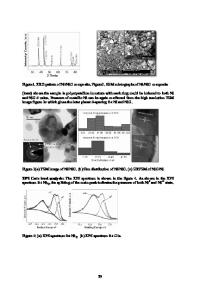Hydrothermal synthesis of Ni-based metal organic frameworks/graphene oxide composites as supercapacitor electrode materi
- PDF / 1,243,106 Bytes
- 12 Pages / 584.957 x 782.986 pts Page_size
- 82 Downloads / 401 Views
Hydrothermal synthesis of Ni-based metal organic frameworks/graphene oxide composites as supercapacitor electrode materials Fan He1, Nana Yang1, Kanshe Li1, Xiaoqin Wang2,a) Shanxin Xiong2,b), Anning Zhou2
, Shaoling Cong1, Linsen Zhang1,
1
College of Chemistry & Chemical Engineering, Xi’an University of Science & Technology, Xi’an 710054, People’s Republic of China College of Chemistry & Chemical Engineering, Xi’an University of Science & Technology, Xi’an 710054, People’s Republic of China; and Key Laboratory of Coal Resources Exploration and Comprehensive Utilization, Ministry of Natural Resources, Xi’an 710021, People’s Republic of China a) Address all correspondence to these authors. e-mail: [email protected] b) e-mail: [email protected] 2
Received: 31 December 2019; accepted: 1 April 2020
As electrode materials, metal-organic frameworks always have low electrical conductivity and poor structural stability, which limits its applications in electrochemical fields. Here, Ni-BPDC/GO composites are synthesized using graphene oxide (GO) as a substrate and 4,49-biphenyldicarboxylic acid (BPDC) as an organic ligand via a hydrothermal approach. The growth mechanism of the Ni-BPDC and Ni-BPDC/GO composites is proposed. In the composites, highly dispersed Ni-BPDC macro-nanostrips are supported on the GO surface in parallel. The presence of GO does not affect the growth and crystalline structure of Ni-BPDC. Compared with the Ni-BPDC, Ni-BPDC/GO composites exhibit higher specific capacitance, rate capability, and operating current density through lowering intrinsic resistance, charge-transfer resistance, and ion diffusion impedance. Moreover, the assembled Ni-BPDC/GO-3//reduced graphene oxide (rGO) asymmetric supercapacitor has large specific capacitance, good cycling stability, and high energy density (16.5 W h/kg at 250 W/kg). Hence, Ni-BPDC/GO composites are a potential electrode material for supercapacitors.
Introduction Energy shortage and environmental deterioration have fueled human interests in making full use of clean and renewable energy resources, including solar energy, wind energy, water energy, tidal energy, biomass energy, and so on [1]. In view of intermittent problems of renewable energy resources, many advanced energy storage devices are exploited to gather excessive renewable energy. Supercapacitors are a fast-growing high-efficiency energy storage device, which have attracted vast attentions of scholars because of their high power density, rapid charge and discharge, excellent cycling stability, long cycle lifetime, and environmental friendliness [2, 3, 4, 5]. In supercapacitor assemblies, electrode materials are a key component affecting device performances and are generally classified into three categories: carbon materials, metal oxides/hydroxides/sulfides, and conductive polymers [6, 7, 8]. The former two materials are commonly applied as
ª Materials Research Society 2020
electrode materials. Carbon materials store energy by means of electric double-layer capacitance (EDLC), whereas metal oxides
Data Loading...











